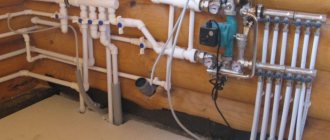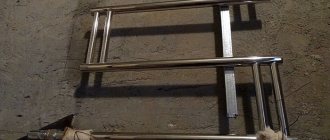Winter is a wonderful time of year, especially in Russia. A sparkling blanket of snow, like a precious holiday decoration, covers the ground, houses and trees. But along with snow and frost, problems come to those who are not prepared for winter, and sometimes very serious ones. Thus, freezing of the water supply threatens the failure of the entire water supply system. Therefore, it is necessary to take care of protecting the pipes even at the stage of building a house, and if this was not done in due time, you need to have time to insulate it before the onset of real cold weather.
What are the dangers of freezing pipes?
As you know, when water freezes it expands. If you pour water into a glass jar and put it in the freezer, after a few hours you will find that ice has formed inside and the jar is cracked. The same thing happens with water pipes - cracks and breaks appear in their walls. After the system defrosts, leaks form in places of damage: water flows out of the formed holes and is absorbed into the ground, gradually forming a flooding zone. At the same time, soil particles enter the water supply system, contaminating the water, which can easily result in an infectious disease or parasitic infestation.
To correct the damage, you have to dig a water supply trench and inspect the entire system. As a rule, in this case, experts advise completely replacing frozen pipes: even if some section of the water supply system looks intact, the resulting microcracks can render it unusable within a couple of years. Therefore, insulating pipes, no matter how expensive it may be, still ends up being a more profitable and reasonable step than repairs that are inevitable after freezing.
Features of protective systems for high-temperature cable heating pipelines
What is the peculiarity of the cable heating system? The following advantages are highlighted:
- Resistance to atmospheric temperature changes. The system can withstand fluctuations from +40 to -40.
- The cable system is not exposed to precipitation.
- Resistance to mechanical damage.
- The double layer of insulation makes it safe and allows it to be used in places where the use of other wires is unacceptable.
Basic ways to combat freezing pipes
The problem of insulating communications arose, in fact, with their appearance. Over more than a hundred years of existence of the central water supply, the following methods have been developed to prevent freezing of pipes and have proven their effectiveness in practice:
- constant circulation of water in pipes;
- immersion of the water supply system in the ground below the frost line;
- insulation of pipes with appropriate materials;
- draining water from pipes for the winter (if the house is used only in the summer);
- insulation of the water supply using a heating cable.
Often several methods are used simultaneously. For example, pipes are buried in the ground and wrapped in insulation or heated with cable. Let's look at each method in more detail to find out its pros and cons.
Ways to prevent freezing
The most effective methods for preventing the formation of ice jams include:
- Correct installation of the pipeline to a sufficient depth.
- Arrangement of sand and gravel cushion.
- Thermal insulation of the system.
- Supply of the pipeline with heating cables with temperature sensors.
Do not overuse heating using a heating cable.
In addition to the fact that this is a significant waste of electricity, continuous operation will shorten its service life several times. Be sure to remember that high-quality protection of pipes at the stage of their installation will greatly facilitate their operation in the future. No matter how carefully the work to warm them is carried out, there is a very high risk of damage from the direct expansion of the ice inside. There is a high probability that with the onset of heat it will be necessary to carry out repair work and replace damaged sections of the system.
Add a comment
Heating with water circulating in pipes
Where does the water in your home water supply come from? It comes either from a well or from a central water supply. In both cases, its temperature at the entry point is above zero, so it can be conditionally considered warm. If warm water constantly flows through the pipes, then the system cannot freeze, since the liquid warms it up with its heat. In the simplest case, it is enough to leave the tap slightly open to avoid ice forming in the pipes.
Of course, the method only works if you have somewhere to drain the water: into a storage tank, into an insulated central sewer, etc. This problem is often solved by draining the water back into the well or well through a second pipe and a three-way valve.
In addition, it is necessary that the speed of movement of the liquid through the pipes be higher than the speed of its freezing, i.e., so that during its flow through the cold, cooling pipe it does not have time to lose all the heat and turn into ice. The lower the outside temperature, the more water needs to be pumped per unit of time. To control the process, you will need a temperature sensor that will regulate the water supply, turning the pump on and off depending on the temperature.
As you can see, the method of constant pumping is quite expensive and difficult to implement, and besides, it cannot be called sufficiently reliable.
Heating section design
The heating section consists of a constant power cable equipped with a three-meter installation wire and a bimetallic thermostat built into the coupling on one side and an end coupling on the other.
The heating cable consists of two heating cores in a screen and a sheath. The connecting and end couplings are factory-made, reliable and sealed.
Burying water pipes
It makes sense to protect the system from frost by hiding it deep in the ground if the freezing point of the soil lies no deeper than one and a half meters from the surface. The method works great in the middle zone and southern regions. To prevent pipes from freezing, the depth of the ditch for laying them should be 15-20 cm lower than the frost line. The financial costs of implementing this method are not particularly high if you dig a trench yourself.
A deep trench is dug from the water intake well or well to the very wall of the house. The bottom is covered with a 10-centimeter layer of sand, the pipes are protected from deformation by a corrugated casing or placed in a wider plastic pipe, then covered with soil removed from the trench. This is the simplest and cheapest method: a layer of soil lying on top of the pipe serves as protection from frost. But for reliability, it is advisable to wrap the water pipes with insulating material before burying them.
Pipe for external sewerage 110x1000mm
Protecting your water supply in winter
The water should be turned off during defrosting. Before commissioning, the pipeline must be checked for integrity. To protect the water supply in winter, you need to insulate it. To do this, use the following methods:
- The depth of the trench should be deeper than the freezing level of the soil.
- Fill the trench with sand or crushed stone. This is necessary for the rapid drainage of water from the surface.
- Slopes should be made towards the well or borehole.
- Thick-walled pipelines must be used.
- For additional insulation, lay out a heat-insulating layer.
- For docking, easily removable parts are used. This is necessary to quickly identify ice jams.
You may be interested in:
Did you know that a country shower also requires preparation for winter? Making a shower in the country with your own hands is not difficult. However, all the work may be useless if the well is not prepared...Read more...
To install an individual pipeline or lay it from a well, use polypropylene parts, not metal ones. This reduces the risk of rupture at low temperatures.
As thermal insulation materials, those that meet the following requirements are selected:
- low heat transfer;
- have maximum resistance to moisture penetration;
- resistant to environmental influences;
- durable.
Foam plastic, polyurethane foam, basalt moisture with a protective layer can be used as insulation.
On a note!
Thermal insulating paint is popular. It is applied using a sprayer.
The paint is convenient to use in hard-to-reach places and is useful for restoring thermal insulation.
You may be interested in:
How is the blind area of a country house done correctly? In the construction of a country house there is a component that is not included in the main list of works - the blind area. Its construction…Read more…
Insulation for water supply
If you use a thick layer of insulation, you don’t have to deepen the trench below the freezing point (but it’s still better not to skimp on depth). After laying, the pipes are covered with a heat-saving shell or wrapped with ordinary rolled material, which is used for installation on walls or roofs. The following types of insulation are usually used.
- Stone wool. Resistant to temperature changes, it protects well from the cold and is quite popular among builders. However, there is one nuance that needs to be taken into account: if the mineral wool gets wet and then the moisture freezes, then after thawing the fibers will fall into fine dust. Consequently, the stone wool shell must be very carefully and reliably waterproofed, eliminating the slightest possibility of moisture seeping from the soil.
- Foamed polyethylene. The inexpensive and practical material has a closed pore structure, which is why it is not afraid of soaking in water. In addition, a foil layer is often laid on top of the insulation, reflecting heat rays into the pipe, which serves as additional protection.
- Expanded polystyrene. A material with a closed bubble structure and is hard enough to support the weight of the soil. It is produced in the form of two halves of a pipe, which are glued together during installation. Protection from the cold is quite reliable, but it is worth keeping in mind that the costs will be slightly higher than when using other insulation materials.
- Styrofoam. Being one of the options for expanded polystyrene, it is significantly inferior in strength, so the heat-saving shell must be supplemented with a box of bricks or concrete slabs.
- Polyurethane foam. Foam insulation is often used in pipe-in-pipe installations. The water pipe is placed in a plastic pipe of larger diameter, and the gap between them is filled with polyurethane foam. This results in reliable and durable protection. Ready-made polyurethane foam shells for pipes are often used, but one must remember that this material is destroyed by prolonged contact with sunlight. The outside of the insulation will have to be covered with a light-proof shell or at least a layer of paint. In addition, for laying water supply and sewerage systems, you can immediately purchase pipes in a PPU sheath, protected by a layer of durable plastic.
- Thermal insulation paint. This is the thinnest, but quite effective insulating layer. The paint contains ceramic microspheres, perlite or foam glass. It is applied to pipes by spraying from a can or with a regular paint brush. Due to the high cost, paint is used only in the most difficult areas that cannot be insulated by other methods.
Insulation for pipes STENOFLEX-400 d34x9mm 2m
The insulation layer must be thick enough to maintain positive water temperatures in the pipes. A waterproofing coating is usually laid on top of it to protect the heat-saving material from getting wet.
What thickness of insulation is required?
Surely, an interested reader will have a question - what should be the thickness of the insulating layer in order to be guaranteed to protect the water pipe from freezing.
The answer to this is not so simple. There is a calculation algorithm that takes into account the mass of initial quantities and includes several formulas that are difficult even for visual perception. This technique is set out in the Code of Rules SP 41-103-2000. If anyone wants to find this document and try to make an independent calculation, you are welcome.
But there is an easier way. The fact is that experts have already taken on the brunt of the calculations - in the same document (SP 41-103-2000), which is easy to find with any search engine, the appendix contains many tables with ready-made insulation thickness values. The only problem is that it is physically impossible to present these tables here in our publication. They are compiled separately for each type of insulation, and are also graded by location - ground, open air or room. In addition, the type of pipeline and the temperature of the pumped liquid are taken into account.
But if you spend 10–15 minutes studying the tables, then you will probably find an option in them that is as close as possible to the conditions that interest the reader.
It would seem that that’s all, but we need to dwell on one more important nuance. It only applies to cases of water pipe insulation with mineral wool.
When it came to this thermal insulation material, a series of mineral wool disadvantages included its tendency to gradual caking and shrinkage. This means that if you initially set only the calculated thickness of the insulation, then after some time the thickness of the insulation layer may become insufficient for complete thermal insulation of the pipe.
Therefore, when performing insulation, it is advisable to lay out a certain reserve of thickness in advance. The question is - which one?
This is easy to calculate. There is a formula that, I think, makes no sense to demonstrate here, since the online calculator we offer is based on it.
The two initial values for the calculation are the outer diameter of the insulated pipe and the recommended value of the thermal insulation thickness found from the tables.
One more parameter remains unclear - the so-called “compaction coefficient”. We take it from the table below, focusing on the selected thermal insulation material and the diameter of the pipe to be insulated.
| Mineral wool insulation, diameter of insulated pipe | Compaction coefficient Kc. |
| Stitched mineral wool mats | 1.2 |
| Thermal insulating mats "TEKHMAT" | 1,35 ÷ 1,2 |
| Mats and sheets made of super-thin basalt fiber (depending on the nominal pipe diameter, mm): | |
| → Du | 3 |
| ̶ the same, with an average density of 50-60 kg/m³ | 1,5 |
| → DN ≥ 800, with an average density of 23 kg/m³ | 2 |
| ̶ the same, with an average density of 50-60 kg/m³ | 1,5 |
| Mats made of glass staple fiber with a synthetic binder, brand: | |
| → M-45, 35, 25 | 1.6 |
| → M-15 | 2.6 |
| Glass spatula fiber mats “URSA”, brand: | |
| → M-11: | |
| ̶ for pipes with DN up to 40 mm | 4,0 |
| ̶ for pipes with DN 50 mm and above | 3,6 |
| → M-15, M-17 | 2.6 |
| → M-25: | |
| ̶ for pipes with DN up to 100 mm | 1,8 |
| ̶ for pipes with DN from 100 to 250 mm | 1,6 |
| ̶ for pipes with a diameter of more than 250 mm | 1,5 |
| Mineral wool slabs with synthetic binder brand: | |
| → 35, 50 | 1.5 |
| → 75 | 1.2 |
| → 100 | 1.1 |
| → 125 | 1.05 |
| Glass staple fiber slabs brand: | |
| → P-30 | 1.1 |
| → P-15, P-17 and P-20 | 1.2 |
Now, armed with all the initial values, you can use the calculator.
Heating cable
Unfortunately, no thermal insulation provides 100% protection against freezing, because it does not heat, but only slows down the cooling process of the water. If you do not use the water supply for a long time, especially in the event of abnormally severe cold, freezing of the pipe will be inevitable. To avoid this, it is necessary to organize heating of the water supply.
The optimal means for this is a special heating cable, which is laid lengthwise on the surface of the pipe or even wound in a spiral. Sometimes it is placed directly inside the pipe, but this method is more difficult to install. A mandatory element of the heating system is a thermostat, which turns on the electric current as soon as the water temperature drops below a predetermined level. Automatic thermoregulation significantly reduces heating costs, since the system is turned on only during those periods when there is a real danger of freezing.
Heating cables can be purchased in ready-made kits designed for a specific pipe length and thermal power. Standard set includes:
- a cable of a certain length, designed for the power specified in the characteristics;
- electrical plug for connection to the electrical network;
- a thermostat that maintains the set temperature by turning on and off the power supply;
- thermostat (not included in all kits), which allows you to independently select the heating temperature.
The cable does not have to be laid along the entire length of the water pipe. Often they only heat the most unprotected areas - the exit from the distribution well and the entry into the house. This is enough to maintain positive water temperature in a house where they live constantly and use running water daily. If you need to protect the system of a house from freezing, which periodically remains empty, then you will have to install heating along the entire length of the pipe. However, the power consumption of the cable is so insignificant that the cost of it will not burden the family budget.
Pipe heating kit ENSTO Plug'n Heat, 4 m, 36 W
An important nuance: in winter, due to bad weather, the power supply to the house may be disrupted, the heating will turn off, and all efforts to insulate will be in vain. To prevent this from happening, it is necessary to purchase a backup power generator that will last for several days until the power line is restored.
Effective ways to heat the mains from the outside
To start working with your own hands, you need to unscrew the water supply taps or the outlet valve. The effectiveness of the technique will be determined by the degree of liquid leakage.
Hot water
If you do not know how to thaw a frozen water pipe connected to a building or located in an unheated basement, use boiling water treatment:
- Wrap the outer section of the line in several layers with rags or old things that absorb liquid well. This will prolong the contact of water and the walls of the product.
- Heat the water to boiling water.
- Cover areas that do not require heating with insulating fabric to prevent movement of the plug.
- Water the wrapped area until the fabric is wet until the ice melts.
- The system warm-up period is up to 12 hours.
Using a hair dryer
A powerful jet of hot air warms up a separate area when the communications are inside the building. The work is performed according to the following algorithm:
- A special casing of film or metal is made around the structure, which eliminates heat loss.
- Open water supply taps and valves.
- Blow the communications evenly from all sides with a construction hairdryer.
- They carefully work out the entrances to the fittings, narrowings and turns to melt the ice.
Using electric current
A welding machine will help melt an ice plug or remove deposits in a pipe underground in a residential building. The device is only suitable for metal structures, since they will be conductors.
Principle of operation
When the device is turned on, an electric field is created, activating the electrons and giving them direction. When the elements collide with ions, they produce thermal energy. Metal products are also heated by the current, and the generated heat is transferred to the ice, so the plug is gradually pushed inside the water pipe.
How to use?
If you do not know how to efficiently heat frozen water in a metal pipe located underground or above the ground in a private house, follow the following procedure:
- Wear thick rubber gloves.
- Open valves and taps.
- Dig or open the desired area.
- Touch the pipe with the electrodes.
- After melting, the water will begin to flow in a thin stream.
"Soldier's boiler" technology
Plastic water supply heats up well if you use a two-core copper wire with a cross-section of 2.5 mm. A homemade tool immersed inside the pipe will gradually boil the liquid and direct it to the drain system. The process is carried out in stages:
- The top insulating layer is removed from the wire.
- A plug for the socket is screwed onto one end of the wire.
- The second core is exposed and wrapped around the pipe for 3-4 turns.
- The excess is cut off with pliers.
- The second core is twisted at a distance of 1-2 mm from the final turn.
- Connect the plug to the electrical outlet.
Air heating
Instead of laying a cable, the water pipe can be heated by warm air coming from the residential building. To do this, it is laid inside a pipe of larger diameter, which is wrapped on the outside with heat-insulating material. Warm air is supplied inside this pipe using a fan, which prevents the water pipe from freezing. The heated air flow must pass unhindered along the entire length of the pipe, from the entrance to the house to the distribution well. Such a system is suitable only for houses in which people constantly live throughout the winter.
Hemstedt FS kit (Germany)
Used to protect small diameter household water pipes.
The built-in thermal limiter controls the temperature and turns off the power when it exceeds +5°C.
The Hemstedt FS kit consists of a resistive cable with termination, thermal limiter and power cable with plug. The kit can only be mounted on the outer surface of the pipe.
Specifications:
| External diameter | 6 mm |
| Minimum bend radius | 5xcable diameter |
| Voltage | 230 V |
| Minimum bend radius | 10 mm |
| Nominal temperature | 65°С |
| Minimum installation temperature | 5°C |
| Resistance deviation tolerance | -5% / +10% |
| Thermostat 16A | Disable +5°С / +15°С |
Assortment of sets of different lengths:
| Length, m | Power, W |
| 1 | 10 |
| 2 | 20 |
| 3 | 30 |
| 4 | 40 |
| 5 | 50 |
| 6 | 60 |
| 7 | 70 |
| 8 | 80 |
| 9 | 90 |
| 10 | 100 |
| 12 | 120 |
| 14 | 140 |
| 18 | 180 |
| 22 | 220 |
| 24 | 240 |
| 28 | 280 |
| 32 | 320 |
| 36 | 360 |
| 48 | 480 |
| 50 | 500 |
| 60 | 600 |
Draining water from pipes
This method is used only for country houses that remain empty throughout the winter. To remove water from the pipes, compressed air is supplied to the system using a compressor, which displaces the liquid. The procedure is as follows.
- Shut off the water supply from the central water supply or from a well.
- Open the tap at the lowest point of the water supply and drain the water remaining in the pipes. The water from the storage tank (if there is one) and the boiler must also be drained and from the toilet cistern down the drain.
- The pneumatic threadless connector of the compressor is connected to the water pipe through a special pneumatic fitting.
- Let air from the compressor into the pipe to push out the remaining water. Repeat several times to remove every last drop.
- Turn off the compressor and close the taps.
- Remove the water remaining in the toilet elbow.
Blowing pipes cannot be called a completely reliable method, since the result is difficult to control. There is always a risk that not all the water has come out of the pipe. Therefore, it makes sense to install electric heating on the pipes of the summer cottage.
Compressor DENZEL RS 1/6-180, 1100 W, 180 l/min, 6 l
Defrosting sewer pipes
In the event that a sewer pipe within a building is frozen, the heating methods described in the previous section will help us. But what to do if a pipe underground on the street freezes? It is pointless to water the soil above it with hot water, and waiting for the onset of heat is too long. There are several ways to correct the situation.
If a metal sewer pipe is frozen, you can use the already mentioned method of heating by applying current. But the difficulty is that you will have to violate the integrity of the soil above the pipe, which is very problematic, since it is frozen. If this frightens you less than the lack of the benefits of civilization over the next three months, then you will need to dig two wells along the edges of the icy area. You can also spend money on purchasing special equipment if this problem is systematic. The actions are almost the same as those already written. The only difference is that there is no need to turn the device on and off (when purchasing a special heating device).
It is impossible to carry out heating using high temperatures immediately in the middle of a frozen area. The melted liquid will have nowhere to go. Always defrost ice from the edges of the mash.
You can act differently. We will need to independently build a simple device from a long piece of two-core cable, a water heating element (TEN), a small board and a fork. We connect a plug to one end of the cable, and a heating element to the other. We make sure that the edge of the base of the heating element rests against the edge of the board, and its spirals do not touch it. The device must be moved using a rigid cable. We insert it inside the pipe from the side that leads to the drain (septic tank). It is impossible to approach the ice jam from the wastewater inlet, since the thawed liquid will have nowhere to leave the system due to its angle of inclination. When the element rests on the ice, we turn it on, when we move it forward a little, we turn it off.
Correct styling
Proper installation will help avoid serious problems such as water freezing, loss of permeability and pipe rupture. The basic requirements are specified in SP 31.13330.2012, which also apply to private housing construction.
Depth
According to building regulations, it is recommended that water pipes be laid below the ground freezing level. Based on the results of long-term observations, special maps or tables are compiled in the coldest months of the year.
The depth of the pipeline depends on the climatic conditions in the region and the composition of the soil at the site. Loams and clays freeze less than sand or rocky soils. So, in the Moscow region this value is in the range from 1.35 to 2 m, in the Krasnodar Territory - 0.3-0.5 m, in Surgut 2.2-2, 9 m.
Soil freezing map
Slope
When laying, you must strictly observe a reverse slope of at least 0.001 towards the well or insertion point. On flat terrain it can be reduced to 0.0005.
The slope should be
This means that the height difference for each linear meter of length should be at least 0.5-1 mm. Even with such a small slope, the water will spontaneously flow back into the well or main line and will not stagnate, creating conditions for the formation of ice.
Mineral wool for pipe insulation
Thermal insulation using varieties of mineral wool has become widespread due to its affordable cost. With its help you can insulate heating pipes, hot water supply, water supply and sewer systems, as well as air ducts. This material works on the principle of a thermos. In addition, cotton wool protects the surface of the pipes from condensation . In the case of insulation of an underground pipeline, it is imperative to provide additional protection from moisture, so when wet, cotton wool loses its protective properties , and heat loss, in turn, increases. Mineral wool is a fibrous material for the production of which various raw materials are used. The most commonly used types are:
- Glass wool – made from the same raw materials that are used to make glass. Its fibers are quite thick. For convenience, glass wool is available in the form of slabs, rolls or shells. To protect against moisture, one side can be covered with foil or a thin layer of aluminum. The thermal conductivity coefficient is 0.030-0.052 W/m*K. The material belongs to the NG class - non-flammable. When installing glass wool, you must be extremely careful and take care of personal protective equipment. Because with any touch to the material, small sharp particles fly in different directions, which dig into the skin even through fabric gloves. It is especially important to protect the organs of vision and breathing, since particles entering the lungs cause severe and prolonged swelling;
- Basalt cotton wool - made from molten rocks. It weighs more than glass wool. The material is also non-flammable and able to withstand exposure to very high temperatures – up to 870°С. Index thermal conductivity more shortthan the previous variety and is 0.035-0.039 W/m*K. Differs more high density and hardness. In this regard, the release form can be either in the form of plates or in the form of cylinders. Additional foil layer can be implemented on both forms;
- Slag wool – made from waste from iron production. For pipe insulation use enough rarely.
This is explained by the increased friability and acidity of the material, on the surface of which oxides form over time, negatively affecting the surface of the pipes . In addition, the material cannot be classified as environmentally friendly. And its thermal conductivity is quite high for a thermal insulation material - 0.46-0.48 W/m*K .











